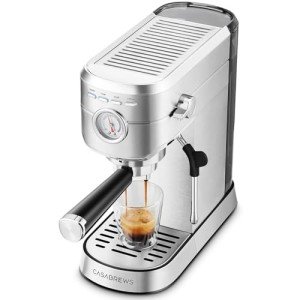Heat Exchange Espresso Machines: A Comprehensive Guide
Espresso machines have evolved significantly throughout the years, accommodating the requirements of home baristas and coffee experts alike. Among these machines, heat exchange espresso machines have actually gotten appeal due to their ability to deliver constant efficiency and extraordinary brew quality. In this article, we will explore the workings, benefits, and crucial functions of heat exchange espresso machines, providing a detailed understanding for both potential buyers and coffee enthusiasts.
Understanding Heat Exchange Technology
Heat exchange espresso machines operate on a special principle that enables synchronised water heating for brewing and steaming. They are geared up with a single boiler that uses a heat exchanger system. This function is substantial as it enables users to brew espresso while steaming milk simultaneously, promoting efficiency in the coffee-making procedure.
How Does a Heat Exchange Espresso Machine Work?
The procedure begins with the machine's water inlet filling the boiler. As the water warms up, it turns to steam. The innovative heat exchanger uses hot steam to heat extra water in a separate passage designed particularly for the brew group. This means that water can reach the perfect developing temperature without waiting on the boiler to adjust. The essential actions include:
- Water Fill: Water is drawn into the boiler.
- Heating Process: The boiler warms up as water is transformed into steam.
- Heat Exchange: Steam warms water in the heat exchanger tube.
- Brewing: Water from the heat exchanger is pushed through coffee grounds, extracting the flavors needed for an abundant espresso.
This process enables for fast temperature changes and enhanced coffee extraction.
Benefits of Heat Exchange Espresso Machines
Heat exchange espresso machines use several advantages, particularly for those seeking to optimize their coffee experience. Here are some crucial benefits:
- Simultaneous Brewing and Steaming: Users can brew espresso while steaming milk, making it ideal for busy cafes and home baristas who value effectiveness.
- Temperature level Stability: The boiler's steam pressure helps maintain a steady temperature, which is crucial for consistent espresso extraction.
- Versatility: The design permits fast switching in between brewing and steaming, making it easier to produce various coffee beverages, from lattes to coffees.
- User-friendly: Models frequently feature available controls, making it practical for both newbies and experienced baristas to produce quality drinks.
- Professional Quality: Heat exchange machines are often used in commercial settings, offering users with high-quality developing performance in the house.
Key Features to Look for in Heat Exchange Espresso Machines
When considering the purchase of a heat exchange espresso machine, there are a number of features that one need to consider:
- Build Quality: Look for machines made of long lasting materials, such as stainless-steel or brass, guaranteeing durability.
- Boiler Size: A larger boiler will hold more water and sustain greater output with time.
- PID Temperature Control: This feature helps preserve constant brew temperatures, which can enhance the coffee-making procedure.
- Group Head Design: Machines with a saturated or semi-saturated group head provide much better temperature level stability.
- Reduce of Use: User-friendly interfaces and user-friendly controls boost the general experience for baristas at all skill levels.
- Steam Wand Quality: A great steam wand with proper insulation and flexibility enables for much better texturing of milk.
- Water Reservoir Size: Depending on your needs, think about how frequently you wish to fill up the water tank.
Comparison of Popular Heat Exchange Espresso Machines
To better understand the options offered in the market, listed below is a contrast table of some popular heat exchange espresso machines:
| Machine Model | Boiler Size | PID Control | Rate Range | User Ratings |
|---|---|---|---|---|
| Profitec Pro 700 | 2.0 L | Yes | ₤ 2,000-₤ 2,500 | 9.5/ 10 |
| Rocket Espresso R58 | 1.8 L | Yes | ₤ 2,400-₤ 2,800 | 9.4/ 10 |
| Elekta Bianca | 1.8 L | Yes | ₤ 2,500-₤ 3,000 | 9.6/ 10 |
| La Spaziale S1 Vivaldi II | 1.5 L | Yes | ₤ 1,800-₤ 2,200 | 9.2/ 10 |
| Bezzera Magica | 1.2 L | No | ₤ 1,600-₤ 1,800 | 9.0/ 10 |
Frequently Asked Questions About Heat Exchange Espresso Machines
What is the primary distinction in between a heat exchange and a dual boiler espresso machine?
While both types can brew espresso and steam milk at the very same time, dual boiler machines have different boilers for developing and steaming. In contrast, heat exchange machines use a single boiler and a heat exchanger to attain the very same function.
Are heat exchange machines appropriate for newbies?
Yes! Lots of heat exchange machines are created with easy to use functions, making them available for newbies. With click through the following web site and practice, users can rapidly produce quality espresso.
What type of upkeep do heat exchange espresso machines require?
Regular maintenance consists of descaling, cleaning up the boiler, inspecting seals and gaskets, and keeping the group head tidy. Regular maintenance makes sure durability and consistent efficiency.
Can I use a heat exchange machine for different kinds of coffee drinks?
Absolutely! Heat exchange machines permit users to create a range of coffee drinks, consisting of espresso, lattes, coffees, and more.
Heat exchange espresso machines represent a mix of innovation and custom, offering coffee enthusiasts with the tools required for crafting the ideal cup. Their capability to all at once brew and steam, integrated with exact temperature level control, makes them a compelling option for both home baristas and experts. With the right knowledge on features and upkeep, users can open a world of splendid coffee experiences, guaranteeing that each sip is as delightful as the last.

